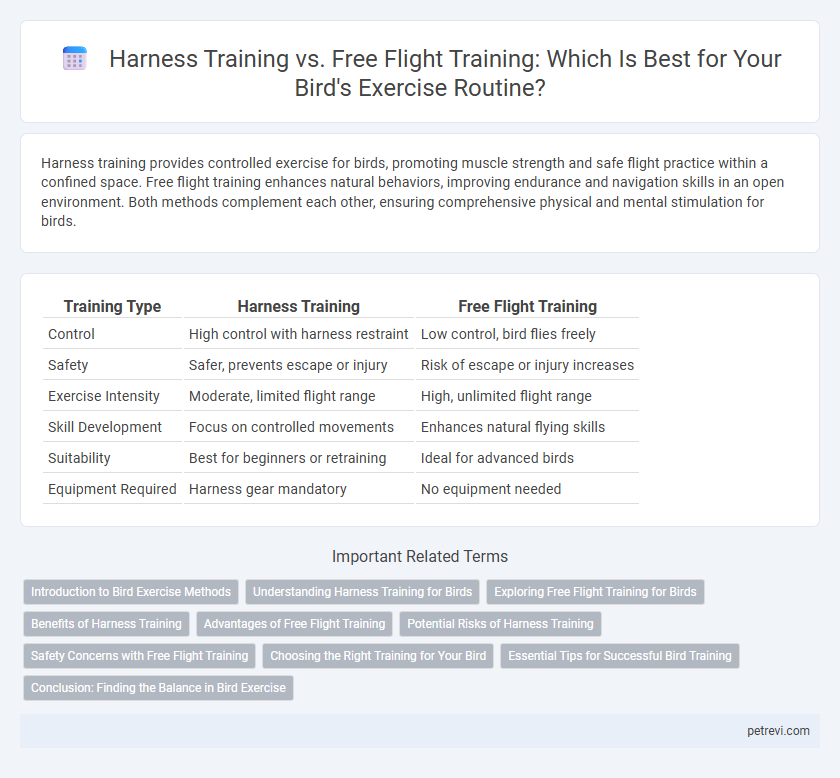Harness training provides controlled exercise for birds, promoting muscle strength and safe flight practice within a confined space. Free flight training enhances natural behaviors, improving endurance and navigation skills in an open environment. Both methods complement each other, ensuring comprehensive physical and mental stimulation for birds.
Table of Comparison
| Training Type | Harness Training | Free Flight Training |
|---|---|---|
| Control | High control with harness restraint | Low control, bird flies freely |
| Safety | Safer, prevents escape or injury | Risk of escape or injury increases |
| Exercise Intensity | Moderate, limited flight range | High, unlimited flight range |
| Skill Development | Focus on controlled movements | Enhances natural flying skills |
| Suitability | Best for beginners or retraining | Ideal for advanced birds |
| Equipment Required | Harness gear mandatory | No equipment needed |
Introduction to Bird Exercise Methods
Harness training involves securing the bird with a lightweight tether, allowing controlled flight while preventing escapes and minimizing injury risks, making it ideal for novice birds learning exercise routines. Free flight training enables birds to fly unrestricted within a designated safe area, promoting natural behaviors, enhancing muscle strength, and improving flight skills through unimpeded movement. Balancing harness and free flight methods optimizes bird fitness and wellbeing by combining safety with natural exercise benefits.
Understanding Harness Training for Birds
Harness training for birds involves gently acclimating them to wear a lightweight, comfortable harness that allows controlled outdoor exercise while preventing escape. This method enhances safety by enabling supervised flight and physical activity, promoting muscle development and mental stimulation without the risks associated with free flight. Understanding proper harness fitting and gradual training techniques is essential to ensure the bird's comfort and build confidence during outdoor exercise sessions.
Exploring Free Flight Training for Birds
Free flight training allows birds to develop natural behaviors and build strength through unrestricted movement, enhancing their agility and cognitive skills. Unlike harness training, free flight encourages self-motivation and environmental interaction, promoting mental stimulation and physical health. This method supports the bird's instinctual need for exploration and provides a more enriching exercise experience.
Benefits of Harness Training
Harness training for birds offers enhanced safety by preventing escapes during exercise and allowing controlled flight practice. This method supports gradual muscle development and confidence building, especially for young or inexperienced birds. Harness training also enables close monitoring of the bird's health and response to exercise, reducing stress and injury risks compared to free flight training.
Advantages of Free Flight Training
Free flight training enhances a bird's natural instincts and flight capabilities by allowing unrestricted movement, promoting stronger muscle development and improved coordination. This method also fosters mental stimulation and confidence by exposing birds to varied environments and challenges. Birds trained through free flight often exhibit better overall health, agility, and responsiveness compared to those restricted in harness training.
Potential Risks of Harness Training
Harness training for birds poses potential risks such as restricted natural movement, which can lead to muscle atrophy and feather damage. Improperly fitted harnesses may cause chafing, bruising, or injury, impacting the bird's overall health and behavior. Birds trained with free flight experience improved physical fitness and mental stimulation without the constraints and hazards associated with harness use.
Safety Concerns with Free Flight Training
Free flight training poses significant safety concerns due to the risk of birds flying into hazards such as power lines, predators, or traffic. Harness training offers controlled exercise by restricting the bird's range, minimizing injury and escape risks. Ensuring a secure environment during free flight is critical to prevent accidents and maintain the bird's wellbeing.
Choosing the Right Training for Your Bird
Harness training offers controlled exercise, preventing accidental escapes and allowing precise monitoring of your bird's activity levels, while free flight training promotes natural behavior and muscle development in a safe, enclosed environment. Selecting the right training depends on your bird's species, temperament, and the availability of a secure outdoor space for free flight sessions. Balancing both methods can optimize physical fitness and mental stimulation, ensuring your bird's well-being.
Essential Tips for Successful Bird Training
Harness training provides controlled exercise and safety for birds, allowing gradual adaptation to new environments and strengthening flight muscles. Free flight training enhances natural behaviors and endurance but requires secure, open spaces and consistent recall commands to prevent escape. Combining both methods with patience, positive reinforcement, and regular monitoring ensures successful bird training outcomes.
Conclusion: Finding the Balance in Bird Exercise
Harness training provides controlled exercise for birds, ensuring safety and gradual strength building, while free flight training enhances natural behaviors and cognitive skills by allowing unrestricted movement. Balancing both methods optimizes physical health and mental stimulation, crucial for a bird's overall well-being. Integrating harness training with periods of free flight creates a comprehensive exercise routine that promotes fitness and enriches natural instincts.
Harness training vs Free flight training for Bird exercise Infographic

 petrevi.com
petrevi.com